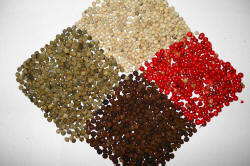Sentences in English
A sentence contains the subject and its predicate. For example:
| Subject | Predicate |
| My brother | came home late |
| She | smokes |
| They and both their friends | came to the party |
| I | enjoyed the play I went to in London last night |
Usually in English, the subject comes first, then the verb and then other information. Some languages are different. How does it work in your language?
Examples in red on this page are wrong!
 |
Subjects, Verbs, Objects + more |
To make a good sentence in English, you need to understand the four important parts. We will take this as the example sentence:
Mary kissed Peter this morning
- The subject
- Mary is the subject of the verb. She kissed
- The verb
- The verb is kiss + ed (making the past tense). It tells us what happened.
- The Object
- The object is Peter. He received the kiss
- More information
- The extra information is this morning. This is a determiner + noun: this + morning.
It tells us when but these
phrases can tell us where (for
example, in the town square). We can have lots of
these, for example, Mary kissed Peter in the town square
this morning at 9 o'clock.
We can also move the phrases. For example:
This morning at 9 o'clock, Mary kissed Peter in the town square
At 9 o'clock this morning Mary kissed Peter in the town square
In the town square this morning at 9 o'clock Mary kissed Peter
Notice that, in English, we must put the subject first. If we say Peter kissed Mary, the meaning is different. In all the examples, we have subject + verb + object. This is how English works and your language may be different. Is it?
All the parts of the sentence can be more than one word but they do the same things. Here are some examples with the subject, the verb and the object in the same colours.
| No. | More information | subject | verb | object 1 | object 2 | More information | |
| 1 |
 |
All day yesterday | the horses | were standing | in the snow | ||
| 2 |
 |
The customer | paid | with a credit card | |||
| 3 |
 |
Yesterday | my father | bought | a new shirt | in town | |
| 4 |
 |
The little boys | gave | the soldier | a beautiful apple | this morning | |
| 5 |
 |
Yesterday | my friend's younger sister | happily rode | her new moped | through the park |
 |
Some things to notice |
- In all the examples, the order is subject + verb + object
- In all the sentences, we must have the subject and the verb.
- The extra information can come before or after the main information.
- In sentences 1 and 2, there are no objects.
The verb stand never takes an object (it is intransitive).
The verb pay can sometimes take an object. It can be transitive (with an object) or intransitive (with no object).
For example:
I paid the shop assistant
and sometimes it does not take an object. For example:
We went to a restaurant and I paid
The verb in sentence 5 (ride) is also sometimes transitive:
I rode a moped
and sometimes intransitive:
I rode into town - In sentence 4, there are two objects: the soldier
and a beautiful apple.
The verb give is always transitive (with an object) but sometimes ditransitive (with two objects). The first object is called the indirect object (the soldier) and the second object is the direct object (a beautiful apple). We can say:
The little boys gave a beautiful apple
but not
The little boys gave the soldier. That's wrong. - In sentence 5 the verb has two words: an adverb, happily,
and the verb, rode.
We call this the verb phrase. - In all sentences, the subject and the object are more than one
word:
Subjects are: the horses, The customer, my father, The little boys, my friend's younger sister, the horses
Objects are: a new shirt, the soldier, a beautiful apple, her new moped
We call these the noun phrases. - In sentence 1, we have all day yesterday and in sentence 4, we have this morning. These are adverb phrases. The word yesterday in sentences 3 and 5 is a simple adverb of time.
- In sentence 1, we have in the snow, in sentence 2 we have with a credit card and in sentence 3 we have through the park. These are all prepositional phrases.
For more about verbs, see the section on Doing and Being words.
 |
The parts of a sentence |
We can have a very simple sentence like:
Peter
cooked dinner
when it is easy to see that Peter
is the subject, cooked
is the verb and dinner
is the object.
Sometimes, the parts of a sentence are longer but they still do
the same thing. For example:
Mary, Peter and the three friends
kindly cooked a really wonderful
dinner.
We can see the parts of the sentence in the same way:

Nothing has changed! We have the subject, then the verb and then the object. This time the subject, the verb and the object are called phrases because they are all more than one word.
There are other phrases we can put into sentences. Here's a list:
| Type of phrase | what it does | example | example sentence |
| noun phrase | can be the subject or the object | the old gardener | The old gardener
talked about it I spoke to the old gardener |
| verb phrase | is the verb | walked carefully | She walked carefully across the road |
| prepositional phrase | tells us where or when | across the road at night |
She walked across the
road She drove at night |
| adverb phrase | tells us about a verb | very slowly and really carefully | I drank the whisky very slowly and really carefully |
| adjective phrase | tells us about a noun phrase | very old and tired | The very old and tired gardener went to sleep |
 |
To understand a sentence in any language, you must look carefully at what the parts are and what they do. It is not too difficult. |
 |
What sentences do in English |
Sentences can do 5 things in English (and most languages). Here they are:
 |
Statements or Positive sentences |
All the examples so far are statements. They say something
positive. For example:
She arrived
She arrived late
I was happy
Mary kissed Peter
I can see her
etc.
|
|
Negatives |
These do the opposite. They say something negative.
For example:
She didn't arrive
She didn't arrive late
I was not happy
Mary didn't kiss Peter
I can't see her
etc.
With most verbs, we use do not, does not or did not
to make the negatives.
With be, have and auxiliary verbs, we just use not.
 |
Questions or Interrogatives |
These ask. We can make three types of questions:
- Simple questions. For example:
Did she arrive?
Did she arrive late?
Were you happy?
Did Mary kiss Peter?
Can you see her?
etc.
With most verbs, we use do, does or did to make the questions.
With be, have and auxiliary verbs, we put the verb first and the subject second.
What does your language do? - Negative questions. For example:
Didn't she arrive?
Didn't she arrive late?
Weren't you happy?
Didn't Mary kiss Peter?
Can't you see her?
etc.
We make these the same way but use the negative forms. - Tag questions. For example:
She arrived, didn't she?
She didn't arrive, did she?
You were happy, weren't you?
You weren't happy, were you?
Mary kissed Peter, didn't she?
Mary didn't kiss Peter, did she?
You can see her, can't you?
You can't see her, can you?
With most verbs, we use do, does or did not at the end after a comma to make the questions.
With be, have and auxiliary verbs, we change the verb and the subject round after the comma.
Many languages have a single tag to do this. What does your language do?
 |
Orders or Imperatives |
These sentences tell other people what to do. This is the
only time we do not use the subject in an English sentence.
Often, we use please with these sentences. They can
be negative or positive imperatives. For example:
Tell her to come, please
Tell me!
Please look at it
Don't tell her
Go!
Please don't go
Be careful!
etc.
With most of these, we just use the verb or the verb with do not
to make the imperative.
 |
Exclamations |
We use these when we are angry or surprised etc. For
example:
What a beautiful day!
How interesting!
How stupid of you!
We use what or how to start these sentences and
they do not have a
verb. Usually, it is simply what / how
+ adjective + noun:
What a simple grammar!
 |
Compound and complex sentences |
All the examples so far are of simple sentences: one subject + one verb. We can make longer sentences by adding ideas together. Like this:
- Compound sentences
-

- In these, we join two equal ideas with a word like and
or but. For example:
She arrived late + He came early = She arrived late and he came early.
She looked for her friend + She didn't find her friend = She looked for her friend but didn't find him
In this example, we do not need to say she again because we know who looked and who didn't find. We can change her friend to him because we know it was her friend.
In compound sentences, the parts can stand alone and mean something correct. - Complex sentences
-

In these we join a main idea to a second idea which is not equal. We use words like so, because, although and when to do this. For example:
It was raining so I took an umbrella
Because it was raining, I took an umbrella
I didn't take an umbrella although it was raining
It wasn't raining when I left the house
These ideas are joined together and cannot stand alone with the correct meaning.
We can have longer sentences using both these things and make a compound-complex sentence. For example:
| It was raining | and | the weather was cold | so | I took an umbrella | and | wore my coat |
Click here to take a simple test on the sentence.
There is a section on Joining ideas in this grammar.
